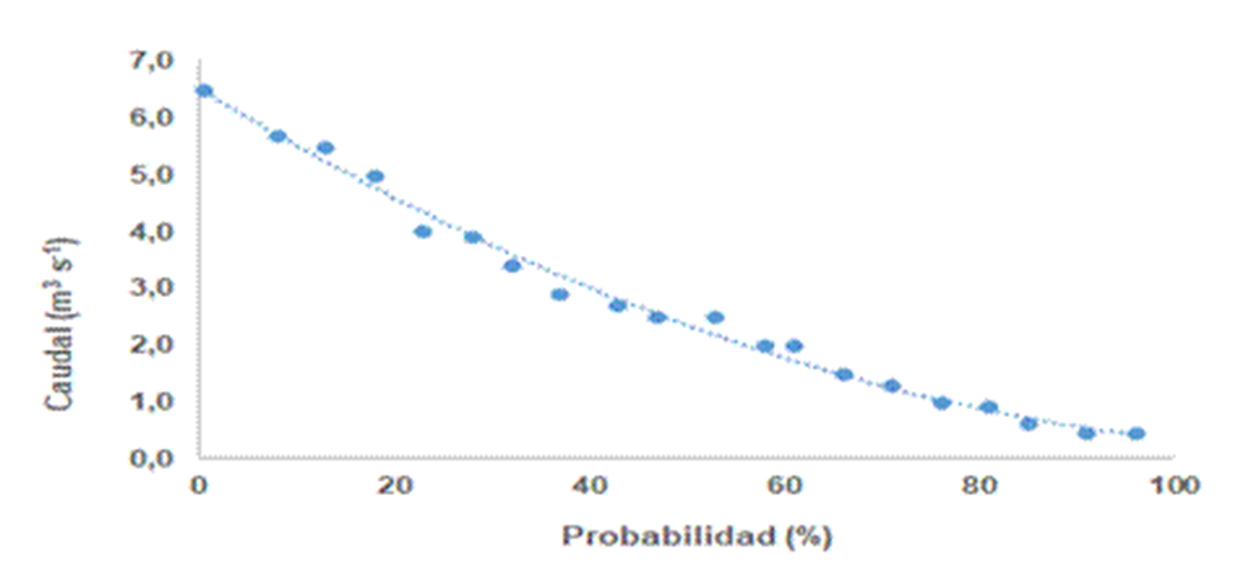Evaluation of hydrological factors of the Chambas Basin for hydroenergy and agricultural use
Main Article Content
Resumo
The evaluation of hydrological factors in hydrographic basins is essential for the sustainable management of water resources and the detailed planning of productive activities in a given area. The present study was developed in the Chambas River Hydrographic Basin with the objective of evaluating different hydrological factors of the basin and their contribution to the generation of hydropower and the supply of water to the agricultural sector. The methodology used consisted of constructing the flow probability curve, estimating the ecological and equipment flow; as well as evaluate the hydroenergy potential and agricultural use of the water stored in the reservoir. The results demonstrated that the daily river flows adequately adjusted the probability of occurrence using a second-order polynomial model. The turbine flow rate of the Francis turbine is 2,08 m3 s-1 and has an absolute frequency of occurrence of 170 times. The ecological flow of the river determined by the wetted perimeter method was 0.038 m3 s-1. The turbine power with the turbined flow rate of 11.30 m3 s-1 offers higher values in relation to the flow rate of 2.08 m3 s-1; However, this last result responds to the hydrological study carried out in the basin. 39% of the water stored in the reservoir is used for food production.
Article Details

Este trabalho encontra-se publicado com a Creative Commons Atribuição-NãoComercial 4.0.
Aquellos autores/as que tengan publicaciones con esta revista, aceptan los términos siguientes:
- Los autores/as conservarán sus derechos de autor y garantizarán a la revista el derecho de primera publicación de su obra, el cuál estará simultáneamente sujeto a la Licencia Creative Commons Attribution-NonCommercial 4.0 International (CC BY-NC 4.0) que permite a terceros compartir la obra siempre que se indique su autor y su primera publicación esta revista. Bajo esta licencia el autor será libre de:
- Compartir — copiar y redistribuir el material en cualquier medio o formato
- Adaptar — remezclar, transformar y crear a partir del material
- El licenciador no puede revocar estas libertades mientras cumpla con los términos de la licencia
Bajo las siguientes condiciones:
- Reconocimiento — Debe reconocer adecuadamente la autoría, proporcionar un enlace a la licencia e indicar si se han realizado cambios. Puede hacerlo de cualquier manera razonable, pero no de una manera que sugiera que tiene el apoyo del licenciador o lo recibe por el uso que hace.
- NoComercial — No puede utilizar el material para una finalidad comercial.
- No hay restricciones adicionales — No puede aplicar términos legales o medidas tecnológicas que legalmente restrinjan realizar aquello que la licencia permite.
- Los autores/as podrán adoptar otros acuerdos de licencia no exclusiva de distribución de la versión de la obra publicada (p. ej.: depositarla en un archivo telemático institucional o publicarla en un volumen monográfico) siempre que se indique la publicación inicial en esta revista.
- Se permite y recomienda a los autores/as difundir su obra a través de Internet (p. ej.: en archivos telemáticos institucionales o en su página web) antes y durante el proceso de envío, lo cual puede producir intercambios interesantes y aumentar las citas de la obra publicada. (Véase El efecto del acceso abierto).
Referências
ARIAS, G.M.D.L.A.: “Cuba: reforma y transformación agraria. La crisis de los noventa y el proceso de desestatalización de la agricultura”, Revista IDeAS, 3(1): 6-29, 2009, ISSN: 2451-6910.
BEDOYA, V.H.; LÓPEZ, L.J.M.: “Modelo para el Control de Inundaciones durante el Fenómeno de “La Niña” Utilizando un Embalse Hidroeléctrico”, Información Tecnológica, 26(2): 89-100, 2015, DOI: https://doi.org/10.4067/S0718-07642015000200011.
BENETTI, A.; LANNA, E.; COBALCHINI, M.: “Metodologías para la determinación de caudales ecológicos en ríos”, Revista Brasileña de Recursos Hídricos, 8(2): 149-160, 2003, ISSN: 2318-0331.
BROWN, M.O.; GALLARDO, B.Y.; WILLIAMS, H.P.W.; TORRES, M.Y.: “Caudal ecológico del río Chambas en la provincia Ciego de Ávila”, Ingeniería hidráulica y ambiental, 37(1): 58-71, 2016, ISSN: 1680-0338.
CASTRO, A.: Minicentrales hidroeléctricas, [en línea], Inst. Instituto para la Diversificación y Ahorro de la Energía (IDAE), Madrid, España, 175 p., 2006, Disponible en: http://dl.idae.es/Publicaciones/10374_Minicentrales_hidroelectricas_A2006.pdf, [Consulta: 18 de enero de 2017].
CAZORLA, C.X.: “Conflictos en el Manejo Integrado de los Recursos Hídricos: la Crisis de la Gobernabilidad y los Usuarios del Agua”, Ecología política, 25: 35-52, 2003, ISSN: 1130-6378.
GALLEGO, A.S.; CARVAJAL, S.L.F.: “Regionalización de curvas de duración de caudales en el Departamento de Antioquia-Colombia”, Revista EIA, 27: 21-30, 2017, ISSN: 1794-1237.
MENDOZA, C.J.; CAMPOS, C.A.: “Análisis Hidrológico de la Cuenca Rocafuerte para Estimar el Potencial Hídrico de la Zona”, Revista Tecnológica - ESPOL, 33(1): 8, 2021, ISSN: 1390-3659, DOI: https://doi.org/10.37815/rte.v33n1.783.
MEZA, P.B.; APARICIO, J.: “Evaluación del potencial hidroenergético a pequeña escala en cuencas hidrológicas con un modelo lluvia-escurrimiento”, Tecnología y Ciencias del Agua, 9(1): 69-87, 2018, ISSN: 0187-8336, DOI: https://doi.org/10.24850/j-tyca-2018-01-05.
MONIRUL, I.M.; ASHFAQ, A.; SALMAN, R.; HEMAL, C.; TAMAL, C.; PIYAL, C.; SADIQ, M.S.; YOUNG, K.P.: “An overview of the hydropower production potential in Bangladesh to meet the energy requirements”, Environ. Eng. Res, 26(6): 200-514, 2021, ISSN: 1226-1025, DOI: https://doi.org/10.4491/eer.2020.514.
PANEQUE, P.L.A.; KINDELÁN, C.L.; COPA, R.J.R.: “Identificación de aspectos ambientales en la comunidad La Victoria, Santiago de Cuba”, Revista Ciencias Técnicas Agropecuarias, 24(1): 65-71, 2015, ISSN: 1010-2760.
PÉREZ, C.B.; GARCÍA, F.L.; FONG, B.J.; DOMÍNGUEZ, A.H.R.; PEÑA, P.L.: “Control del proyecto de una mini hidroeléctrica auxiliar para una pequeña central”, Ingeniería Mecánica, 25(2): 647, 2022, ISSN: 1815-5944.
REYNA, T.; REYNA, S.; LÁBAQUE, M.; RIHA, C.; GÓNGORA, C.: “Desafíos ambientales para uso de la hidrogeneración”, Avances en Ciencias e Ingeniería, 8(3): 1-12, 2017, ISSN: 0718-8706.
RIVERA, J.A.; PENALBA, O.C.: “Distribución de probabilidades de los caudales mensuales en las regiones de cuyo y patagonia (Argentina): Aplicación al monitoreo de sequías hidrológicas”, Meteorológica, 43(2): 25-46, 2018, ISSN: 1850-468X.
